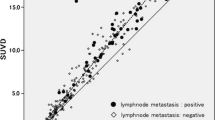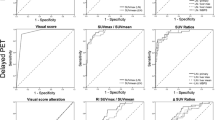Abstract
Objective
The objective of this study was to retrospectively evaluate whether delayed additional F-18-fluorodeoxyglucose positron emission tomography (FDG-PET) imaging can improve the certainty of this modality in evaluating lymph node metastasis in patients with non-small-cell lung cancer (NSCLC).
Methods
Eighty-three patients with NSCLC were examined. FDG-PET imaging (whole body) was performed at 1-h (early) post-FDG injection and repeated 2 h (delayed) after injection only in the thoracic area. The PET images were evaluated qualitatively for regions of focally increased metabolism. If a lymph node was visible on the PET image, the semi-quantitative analysis using the standardized uptake value (SUV) was determined for both early and delayed images (SUVearly and SUVdelayed, respectively). Retention index (RI) was then calculated on the basis of the following equation: (SUVdelayed − SUVearly) × 100/SUVearly. The RI value of more than 0% was taken to be the PET criterion for malignancy.
Results
For early and delayed PET, sensitivities for lymph node staging were 54% and 62%, respectively, specificities were 89% for both, and accuracies were 78% and 81%, respectively. The results of combined delayed PET and RI showed a sensitivity of 62%, specificity of 96%, and accuracy of 86%.
Conclusions
Dual-time-point FDG-PET (combined delayed PET and RI) showed better (although not statistically significant) specificity, positive predictive value, and accuracy than early or delayed PET alone for lymph node staging in NSCLC.
Similar content being viewed by others
References
Tanaka F, Yanagihara K, Otake Y, Miyahara R, Kawano Y, Nakagawa T, et al. Surgery for non-small-cell lung cancer: postoperative survival based on the revised tumor-nodemetastasis classification and its time trend. Eur J Cardiothorac Surg 2000;18:147–155.
Barker JM, Silvestri GA. Lung cancer staging. Curr Opin Pulm Med 2002;8:287–293.
McLoud TC, Bourgouin PM, Greenberg RW, Kosiuk JP, Templeton PA, Shepard JA, et al. Bronchogenic carcinoma: analysis of staging in the mediastinum with CT by correlative lymph node mapping and sampling. Radiology 1992;182:319–323.
Scott WJ, Gobar LS, Terry JD, Dewan NA, Sunderland JJ. Mediastinal lymph node staging of non-small-cell lung cancer: a prospective comparison of computed tomography and positron emission tomography. J Thorac Cardiovasc Surg 1996;111:642–648.
Rohren EM, Turkington TG, Coleman RE. Clinical applications of PET in oncology. Radiology 2004;231:305–332.
Marom EM, McAdams HP, Erasmus JJ, Goodman PC, Culhane DK, Coleman RE, et al. Staging non-small cell lung cancer with whole-body PET. Radiology 1999;212:803–809.
Demura Y, Tsuchida T, Ishizaki T, Mizuno S, Totani Y, Ameshima S, et al. 18F-FDG accumulation with PET for differentiation between benign and malignant lesions in the thorax. J Nucl Med 2003;44:540–548.
Gould MK, Kuschner WG, Rydzak CE, Maclean CC, Demas AN, Shigemitsu H, et al. Test performance of positron emission tomography and computed tomography for mediastinal staging in patients with non-small-cell lung cancer: a meta-analysis. Ann Intern Med 2003;139:879–892.
Yamamoto Y, Nishiyama Y, Monden T, Sasakawa Y, Ohkawa M, Gotoh M, et al. Correlation of FDG-PET findings with histopathology in the assessment of response to induction chemoradiotherapy in non-small cell lung cancer. Eur J Nucl Med Mol Imaging 2006;33:140–147.
Steinert HC, Hauser M, Allenman F, Engel H, Berthold T, von Schulthess GK, et al. Non-small cell lung cancer: nodal staging with FDG PET versus CT with correlative lymph node mapping and sampling. Radiology 1997;202:441–446.
Vansteenkiste JF, Stroobants SG, De Leyn PR, Dupont PJ, Bogaert J, Maes A, et al. Lymph node staging in NSCLC with FDG-PET: a prospective study on 690 lymph node stations from 68 patients. J Clin Oncol 1998;16:2142–2149.
Shreve PD, Anzai Y, Wahl RL. Pitfalls in oncologic diagnosis with FDG PET imaging: physiologic and benign variants. Radiographics 1999;19:61–77.
Zhuang H, Pourdehnad M, Lambright ES, Yamamoto AJ, Lanuti M, Li P, et al. Dual time point 18F-FDG PET imaging for differentiating malignant from inflammatory processes. J Nucl Med 2001;42:1412–1417.
Yamada S, Kubota K, Kubota R, Ido T, Tamahashi N. High accumulation of fluorine-18-fluorodeoxyglucose in turpentine-induced inflammatory tissue. J Nucl Med 1995;36:1301–1306.
Kubota K, Itoh M, Ozaki K, Ono S, Tashiro M, Yamaguchi K, et al. Advantage of delayed whole-body FDG-PET imaging for tumour detection. Eur J Nucl Med 2001;28:696–703.
Matthies A, Hickeson M, Cuchiara A, Alavi A. Dual time point 18F-FDG PET for the evaluation of pulmonary nodules. J Nucl Med 2002;43:871–875.
Greene FL, Page DL, Fleming ID, Fritz A, Balch CM, Haller DG, Morrow M, editors. AJCC cancer staging manual. 6th ed. New York: Springer; 2002, p. 165–177.
Yoon YC, Lee KS, Shim YM, Kim BT, Kim K, Kim TS. Metastasis to regional lymph nodes in patients with esophageal squamous cell carcinoma: CT versus FDG PET for presurgical detection-prospective study. Radiology 2003;227:764–770.
Kubota R, Yamada S, Kubota K, Ishiwata K, Tamahashi N, Ido T. Intratumoral distribution of fluorine-18-fluorodeoxyglucose in vivo: high accumulation in macrophages and granulation tissues studied by microautoradiography. J Nucl Med 1992;33:1972–1980.
Dwamena BA, Sonnad SS, Angobaldo JO, Wahl RL. Metastases from non-small cell lung cancer: mediastinal staging in the 1990s-meta analytic comparison of PET and CT. Radiology 1999;213:530–536.
Kim BT, Lee KS, Shim SS, Choi JY, Kwon OJ, Kim H, et al. Stage T1 non-small cell lung cancer: preoperative mediastinal nodal staging with integrated FDG PET/CT-a prospective study. Radiology 2006;241:501–509.
Chung JH, Cho KJ, Lee SS, Baek HJ, Park JH, Cheon GJ, et al. Overexpression of Glut1 in lymphoid follicles correlates with false-positive 18F-FDG PET results in lung cancer staging. J Nucl Med 2004;45:999–1003.
Author information
Authors and Affiliations
Corresponding author
Rights and permissions
About this article
Cite this article
Nishiyama, Y., Yamamoto, Y., Kimura, N. et al. Dual-time-point FDG-PET for evaluation of lymph node metastasis in patients with non-small-cell lung cancer. Ann Nucl Med 22, 245–250 (2008). https://doi.org/10.1007/s12149-007-0103-2
Received:
Accepted:
Published:
Issue Date:
DOI: https://doi.org/10.1007/s12149-007-0103-2




